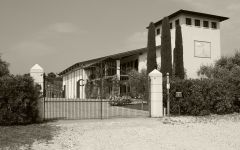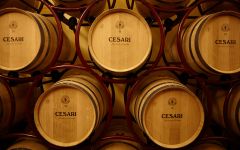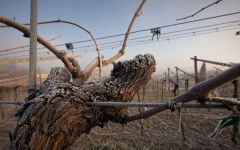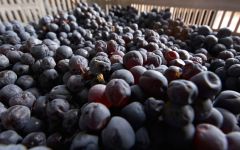Cesari Amarone della Valpolicella Bosan Riserva 2009
-
Robert
Parker -
Wine
Spectator -
Wine
Enthusiast -
James
Suckling



Product Details
Your Rating
Somm Note
Winemaker Notes
Professional Ratings
-
Robert Parker's Wine Advocate
The 2009 Amarone della Valpolicella Classico Riserva Bosan is extraordinary, really. It's a huge wine, and although you get lots of ripe fruit, you also get savory notes of tobacco and spice. It is immense and seamless, showing more elegance than other vintages, with a thin mouthfeel. It seems much younger than it is. This blend of 80% Corvina and 20% Rondinella also provides some lingering sweetness on the close, which is infused with spice, tar and camphor ash, a nice choice for lamb shank ravioli. The wine ages in a combination of large oak Slavonian casks and barrique for almost five years and then about a year in the bottle. Some 21,000 bottles were made.
-
Wine Spectator
Tarry smoke and tobacco notes are a savory lead-in for this fresh, full-bodied red, wrapping around a firm frame of well-knit tannins and more subtle flavors of baked cherry, woodsy spice and espresso. Fine finish. Best from 2020 through 2029.
-
Wine Enthusiast
Smoke, leather, scorched earth, mature plum and baking-spice aromas mingle together. The brooding robust palate evokes morello cherry marinated in spirits, prune, licorice and clove alongside a network of taut close-grained tannins. A note of roasted coffee bean marks the close. Drink through 2024.
-
James Suckling
Rich and flavorful with soft and velvety tannins and lots of subtle raisins, chocolate and walnuts. Medium-bodied and layered. Fruity at the end. Showing well now.
Other Vintages
2013-
James
Suckling -
Robert
Parker -
Wine
Spectator
-
James
Suckling
-
Robert
Parker -
Wine
Enthusiast -
Wine
Spectator -
James
Suckling






Cesari was founded in 1936 by Gerardo Cesari who set out to produce an Amarone capable of competing with the great red wines of the world. Joined by his son Franco in the early 1960s, operations were expanded in an effort to conquer the export market. As one of the first Italian wines to be exported to all five continents, the Cesari name quickly became synonymous with Amarone the world round.
The winery continues to evolve while staying true to its regional roots. Franco’s children, Gerardo and Deborah, have joined their father in upholding the pillars of traditional winemaking while introducing innovative technology at their two state-of-the-art cellars.
Their estate holdings include more than 100 hectares of hillside vineyards located in premier sites in the Valpolicella appellation, including 3 single vineyards, primarily in the historic Classico area. An additional 10 hectares of 100% estate-managed vineyards under long-term lease are located throughout the Veneto region. All are primarily planted to indigenous varietals, with a small percentage of international grapes, carefully harvested by hand ensuring that only the best grapes are selected. In recent years, Cesari has adopted environmentally sustainable growing practices. Focused on quality, Cesari extensively ages their wines beyond the DOCG regulations.
The Cesari portfolio is comprised of unique, elegant, and balanced appellation wines renowned for authenticity, respected for regional character, and distinguished for superior quality.

With hundreds of red grape varieties to choose from, winemakers have the freedom to create a virtually endless assortment of blended red wines. In many European regions, strict laws are in place determining the set of varieties that may be used, but in the New World, experimentation is permitted and encouraged resulting in a wide variety of red wine styles. Blending can be utilized to enhance balance or create complexity, lending different layers of flavors and aromas. For example, a red wine blend variety that creates a fruity and full-bodied wine would do well combined with one that is naturally high in acidity and tannins. Sometimes small amounts of a particular variety are added to boost color or aromatics. Blending can take place before or after fermentation, with the latter, more popular option giving more control to the winemaker over the final qualities of the wine.
How to Serve Red Wine
A common piece of advice is to serve red wine at “room temperature,” but this suggestion is imprecise. After all, room temperature in January is likely to be quite different than in August, even considering the possible effect of central heating and air conditioning systems. The proper temperature to aim for is 55° F to 60° F for lighter-bodied reds and 60° F to 65° F for fuller-bodied wines.
How Long Does Red Wine Last?
Once opened and re-corked, a bottle stored in a cool, dark environment (like your fridge) will stay fresh and nicely drinkable for a day or two. There are products available that can extend that period by a couple of days. As for unopened bottles, optimal storage means keeping them on their sides in a moderately humid environment at about 57° F. Red wines stored in this manner will stay good – and possibly improve – for anywhere from one year to multiple decades. Assessing how long to hold on to a bottle is a complicated science. If you are planning long-term storage of your reds, seek the advice of a wine professional.

Among the ranks of Italy’s quintessential red wines, Valpolicella literally translates to the “valley of cellars” and is composed of a series of valleys (named Fumane, Marano and Negrare) that start in the pre-alpine Lissini Mountains and end in the southern plains of the Veneto. Here vineyards adorn the valley hillsides, rising up to just over 1,300 feet.
The classification of its red wines makes this appellation unique. Whereas most Italian regions claim the wines from one or two grapes as superior, or specific vineyards or communes most admirable, Valpolicella ranks the caliber of its red wines based on delimited production methods, and every tier uses the same basic blending grapes.
Corvina holds the most esteem among varieties here and provides the backbone of the best reds of Valpolicella. Also typical in the blends, in lesser quantities, are Rondinella, Molinara, Oseleta, Croatina, Corvinone and a few other minor red varieties.
Valpolicella Classico, the simplest category, is where the region’s top values are found and resembles in style light and fruity Beaujolais. The next tier of reds, called Valpolicella Superiore, represents a darker and more serious and concentrated expression of Valpolicella, capable of pairing with red meat, roast poultry and hard cheeses.
Most prestigious in Valpolicella are the dry red, Amarone della Valpolicella, and its sweet counterpart, Recioto della Valpolicella. Both are created from harvested grapes left to dry for three to five months before going to press, resulting in intensely rich, lush, cerebral and cellar-worthy wines.
Falling in between Valpolicella Superiore and Amarone is a style called Valpolicella Ripasso, which has become immensely popular only since the turn of the century. Ripasso literally means “repassed” and is made by macerating fresh Valpolicella on the pressed grape skins of Amarone. As a result, a Ripasso will have more depth and complexity compared to a regular Superiore but is more approachable than an Amarone.
